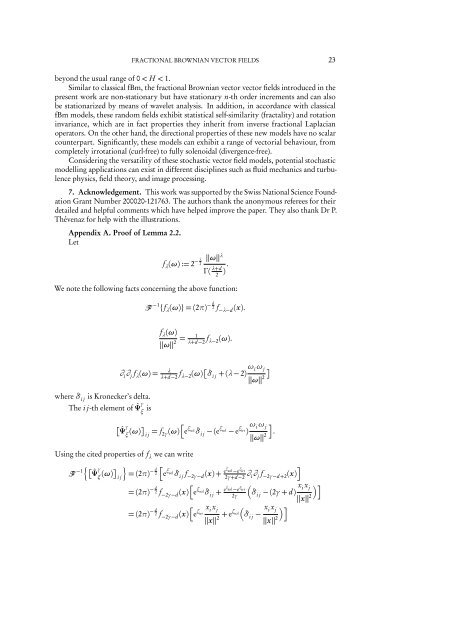FRACTIONAL BROWNIAN VECTOR FIELDS 1. Introduction. A one ...
FRACTIONAL BROWNIAN VECTOR FIELDS 1. Introduction. A one ...
FRACTIONAL BROWNIAN VECTOR FIELDS 1. Introduction. A one ...
You also want an ePaper? Increase the reach of your titles
YUMPU automatically turns print PDFs into web optimized ePapers that Google loves.
<strong>FRACTIONAL</strong> <strong>BROWNIAN</strong> <strong>VECTOR</strong> <strong>FIELDS</strong> 23<br />
beyond the usual range of 0 < H < <strong>1.</strong><br />
Similar to classical fBm, the fractional Brownian vector vector fields introduced in the<br />
present work are non-stationary but have stationary n-th order increments and can also<br />
be stationarized by means of wavelet analysis. In addition, in accordance with classical<br />
fBm models, these random fields exhibit statistical self-similarity (fractality) and rotation<br />
invariance, which are in fact properties they inherit from inverse fractional Laplacian<br />
operators. On the other hand, the directional properties of these new models have no scalar<br />
counterpart. Significantly, these models can exhibit a range of vectorial behaviour, from<br />
completely irrotational (curl-free) to fully solenoidal (divergence-free).<br />
Considering the versatility of these stochastic vector field models, potential stochastic<br />
modelling applications can exist in different disciplines such as fluid mechanics and turbulence<br />
physics, field theory, and image processing.<br />
7. Acknowledgement. This work was supported by the Swiss National Science Foundation<br />
Grant Number 200020-121763. The authors thank the anonymous referees for their<br />
detailed and helpful comments which have helped improve the paper. They also thank Dr P.<br />
Thévenaz for help with the illustrations.<br />
Appendix A. Proof of Lemma 2.2.<br />
Let<br />
f λ (ω) := 2 − λ 2<br />
‖ω‖ λ<br />
Γ( λ+d<br />
2 ).<br />
We note the following facts concerning the above function:<br />
−1 { f λ (ω)} = (2π) − d 2 f−λ−d (x).<br />
f λ (ω)<br />
‖ω‖ 2 = 1<br />
λ+d−2 f λ−2 (ω).<br />
∂ i ∂ j f λ (ω) =<br />
where δ i j is Kr<strong>one</strong>cker’s delta.<br />
The i j -th element of ˆΨ γ ξ is<br />
λ<br />
λ+d−2 f λ−2 (ω) δ i j + (λ − 2) ω i ω j <br />
‖ω‖ 2<br />
<br />
ˆΨγ (ω) ω<br />
= f<br />
ξ i j 2γ (ω) e ξ sol δi j − (e ξ sol − e<br />
ξ irr) i ω j<br />
<br />
.<br />
‖ω‖ 2<br />
Using the cited properties of f λ we can write<br />
−1 <br />
ˆΨγ (ω) = (2π) − d 2<br />
ξ i j<br />
<br />
e ξ sol δi j f −2γ−d (x) + eξ sol −e ξ irr<br />
2γ+d−2 ∂ i ∂ j f −2γ−d+2 (x)<br />
<br />
= (2π) − d 2 f−2γ−d (x) e ξ sol δi j + eξ sol −e ξ irr<br />
2γ<br />
<br />
= (2π) − d 2 f−2γ−d (x)<br />
e ζ irr<br />
x i x j<br />
‖x‖ + 2 eζ sol<br />
<br />
δ i j − (2γ + d) x i x j<br />
‖x‖ 2 <br />
<br />
δ i j − x i x j<br />
‖x‖ 2
















